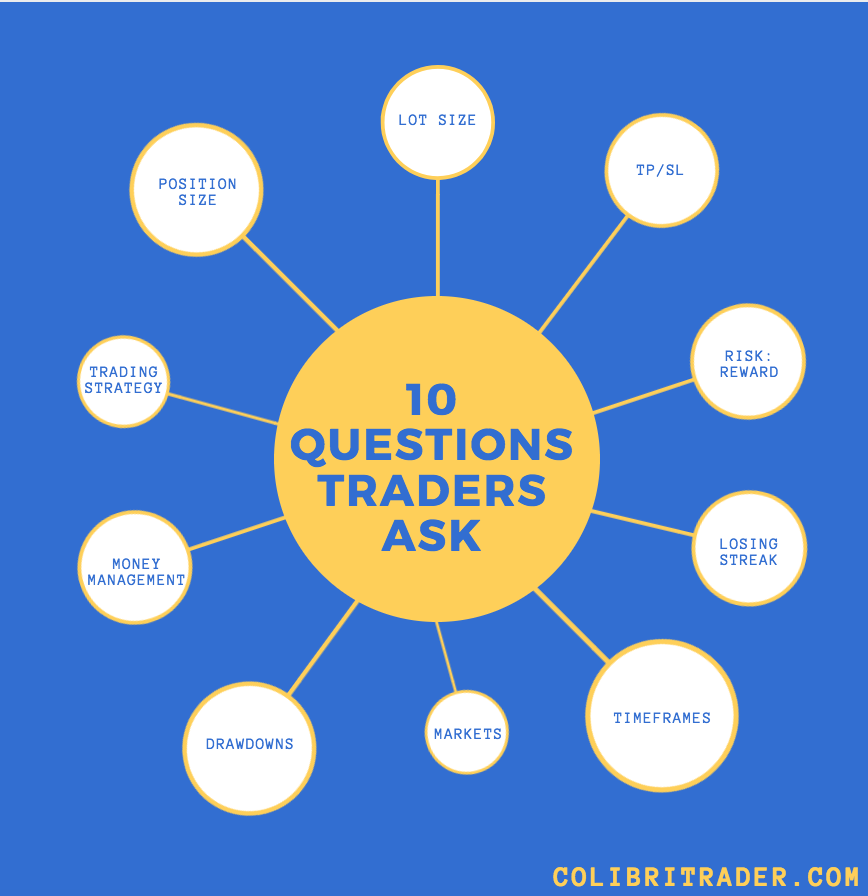He took the time and courage to ask me questions, which might be considered by a lot very basic, but I think that exactly this type of questions are the ones you should be asking yourselves, even if you were a pro trader.
The ability to ask ourselves simple (yet essential) questions is the epitome of good trading practices.
What are good options trading questions to ask?
Let me start off by sharing with you the questions I have been asked myself. This will provide you with a lot of material to think about.
Question 1. How do you calculate your lot size / position sizing?
Answer: That is not a difficult question to answer, although a lot of traders are underestimating the importance of it. In order to calculate lot size, you will need to determine the pip cost of a trade.
Pip size might differ between different brokers, but that is pretty much how much you will lose or make per pip. As your lots increase so your pips cost. The opposite is valid when you trade smaller lots- your profit per pip will decrease, as well.
This handsomely leads us to the next question…
Question 2. How many percent do you risk for every trade? And do you also calculate the swap and commission included?
Answer: Your position should not be more than 1-2% of your capital. So, let’s say your capital is 1,000GBP, you should not risk more than 10-20GBP per trade.
Regarding the SWAP, each broker has its overnight swap rates based on the LIBOR % rate. I personally don’t risk more than 0.5-1.0% per trade. In my opinion, every time you risk more than 2% of your equity will lead to a self-destruction mode sooner or later.
As traders, we must preserve what is most sacred to us- our capital. Since it is our only asset, we should treat it with more care than anything else- even the trading strategy.
I believe traders do spent too much time on their trading strategies and almost zero time on thinking about their risk appetite.
Question 3. Should we do trailing stop after we open position or just let the price running either hit TP or hit SL?
Answer: It is thoroughly discretionary. I tend to use them 80% of the time, especially when price has moved and is about 50% away from my target. It will depend from one position to another, but this is something I have covered in my
trading course in more details. Especially, how to stay in a winning position longer and cut losses faster.
Question 4. For exit trade: do you set TP on S/R level or using fixed Risk:Reward 1 ratio or other tools?
Answer: For exit, I do use TP based on a previous support or resistance area. I do also monitor price action around those major levels and am looking for a confirmation that the trade is exhausted and is about to turn.
In case the price shows confirmation of strong momentum, I am not in a rush to get out of a trade. I always consult with price on the daily chart. All of my students that have taken my trading course know exactly what I mean.
Sometimes, if a target is reached and price shows signs of exhaustion and a reversal pattern is in place, then I might even consider taking a position in the opposite direction.
Question 5. How do you handle your losing streak position? Reduce position size? Or stop trading after some number of consecutive loss? Or…?
Answer: If I have one losing position, I stop trading for the day. I try to be as disciplined as possible!
Don’t forget that another opportunity will come along, but if you lose your emotional balance, it is much more difficult to come back to the ZONE.
You need to be absolutely balanced and with no distractions when taking important trading decisions. Therefore, if you have already taken a losing position, chances are your ego might interfere and lead you to some wrong decisions.
Knowing that already- will you be willing to take the risk and take another trade after a losing one? I don’t think so.
Capital is your only asset. Hence, you need to think how to best preserve it. Take a break, step back, relax- tomorrow is another day!
Question 6. Your main rule is to watch the Daily Time frame for Directional Bias and then trigger the entry on H4. If on H4 there is no clear pattern to trigger the entry, should we stay out or keep forcing the trade using D1 pattern as a trigger?
Answer: The way I trade, I am always looking for a signal from the Daily timeframe. Then, I switch down to H4 to get a confirmation. If there is no confirmation from the 4H chart, I usually do not take a trade.
Trading straight off the Daily chart is possible, but you need to use a much wider stop-loss. I still need 4H chart for my trading strategy, which allows me to maximise profits and minimise losses- which should be the goal of every trader!
Question 7. What about handling draw downs? Is there any strategy for handling drawdowns condition?
Answer: Take a longer holiday or time off the screens. If trading is the only thing in your life, then you should reconsider your work-life balance. Trading takes only 1/5 of my life-work balance. You should find other things that make you happy and self-fulfilled and not put in all of your efforts and time in trading. I hope you understand me right!
Question 8: May i know. How many markets should we focused for learning phase? Watch all Forex Major pair or we need to focus on 2 or 3 pair first maybe?
Answer: I am personally looking at all major and minor FX markets and some indices, as you have seen from my market analysis section. Sometimes you will receive a lot of signals from the daily chart, but that is the time to choose based on the support/resistance rule- which ones have the highest likeness of happening.
Demo practice would be really welcome, so you can experiment as much as you wish.
Usually, if you have a retracement to a major support/resistance level and a confluence with a price action signal and another pair with just a signal and no major support/resistance level in close proximity- this will give you my answer. I would go with the one that is showing more signs of confirmation, i.e. the former one.
Question 9: Basically is there any good money management rule for maximum risk per day for open position?
Answer: Again- you should not risk more than 1-2% per trade. If you already have open positions, you should add to only winning trades. Do not add positions to losing trades- this is called averaging down and is definitely not a place you want to be in.
Question 10: If you had one losing position will you stop trading for the rest of the day?
Answer: Yes, that is correct. On this topic, please go ahead and read two of my articles specially dedicated on that topic.
Bear in mind that one of the biggest mistakes of beginner traders is overtrading- please don’t make this mistake.
Here are the articles:
Instead of Conclusion
In the end, 10 questions that traders ask could be 100 or 1,000 but what is important to note is that trading is not a straightforward process. It takes time to master and patience to improve.
If there is one thing that you should take from this article is that the basic questions that beginner traders ask are the essential ones that one needs to succeed in this hard field.
Trading like a pro requires asking those basic questions over and over again!
Trading like a pro requires one to accept that he/she is not perfect and is able and willing to change.
Trading like a pro also means that you are able to put your ego and emotions behind your desire to make quick bucks.
The 10 questions traders ask should start with simply the desire to learn and improve!
About the author: Colibri Trader is a price action trader that is constantly looking for the apha. In the meantime, he does not forget to enjoy life, travel and even mentor other traders. This article was originally published here.










There are no comments to display.
Join the conversation
You can post now and register later. If you have an account, sign in now to post with your account.
Note: Your post will require moderator approval before it will be visible.